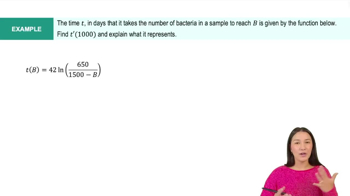Table of contents
- 0. Functions7h 52m
- Introduction to Functions16m
- Piecewise Functions10m
- Properties of Functions9m
- Common Functions1h 8m
- Transformations5m
- Combining Functions27m
- Exponent rules32m
- Exponential Functions28m
- Logarithmic Functions24m
- Properties of Logarithms34m
- Exponential & Logarithmic Equations35m
- Introduction to Trigonometric Functions38m
- Graphs of Trigonometric Functions44m
- Trigonometric Identities47m
- Inverse Trigonometric Functions48m
- 1. Limits and Continuity2h 2m
- 2. Intro to Derivatives1h 33m
- 3. Techniques of Differentiation3h 18m
- 4. Applications of Derivatives2h 38m
- 5. Graphical Applications of Derivatives6h 2m
- 6. Derivatives of Inverse, Exponential, & Logarithmic Functions2h 37m
- 7. Antiderivatives & Indefinite Integrals1h 26m
- 8. Definite Integrals4h 44m
- 9. Graphical Applications of Integrals2h 27m
- 10. Physics Applications of Integrals 2h 22m
3. Techniques of Differentiation
The Chain Rule
Problem 82e
Textbook Question
{Use of Tech} Cell population The population of a culture of cells after t days is approximated by the function P(t)=1600 / 1 + 7e^−0.02t, for t≥0.
e. Graph the growth rate. When is it a maximum and what is the population at the time that the growth rate is a maximum?
 Verified step by step guidance
Verified step by step guidance1
Step 1: Identify the function for the population growth rate. The growth rate is the derivative of the population function P(t) with respect to time t. So, find P'(t) by differentiating P(t) = \frac{1600}{1 + 7e^{-0.02t}}.
Step 2: Use the quotient rule to differentiate P(t). The quotient rule states that if you have a function \frac{u}{v}, its derivative is \frac{u'v - uv'}{v^2}. Here, u = 1600 and v = 1 + 7e^{-0.02t}.
Step 3: Differentiate u and v. Since u = 1600 is a constant, u' = 0. For v = 1 + 7e^{-0.02t}, use the chain rule to find v'. The derivative of e^{-0.02t} is -0.02e^{-0.02t}, so v' = -0.14e^{-0.02t}.
Step 4: Substitute u, u', v, and v' into the quotient rule formula to find P'(t). Simplify the expression to get the growth rate function.
Step 5: To find when the growth rate is maximum, set the derivative of the growth rate function (P''(t)) to zero and solve for t. This will give the critical points. Evaluate P(t) at this t to find the population at the time when the growth rate is maximum.
 Verified video answer for a similar problem:
Verified video answer for a similar problem:This video solution was recommended by our tutors as helpful for the problem above
Video duration:
11mPlay a video:
Was this helpful?
Key Concepts
Here are the essential concepts you must grasp in order to answer the question correctly.
Logistic Growth Model
The function P(t) = 1600 / (1 + 7e^(-0.02t)) represents a logistic growth model, which describes how populations grow in a limited environment. Initially, the population grows exponentially, but as resources become limited, the growth rate decreases and approaches a maximum carrying capacity, in this case, 1600 cells.
Recommended video:

Derivative of the Natural Logarithmic Function Example 7
Derivative and Growth Rate
To find the growth rate of the population, we need to compute the derivative of P(t) with respect to t, denoted as P'(t). This derivative indicates how the population changes over time, and finding its maximum involves setting P'(t) to zero and solving for t, which reveals when the population growth is at its peak.
Recommended video:

Intro To Related Rates
Critical Points and Maximum Values
Critical points occur where the derivative P'(t) is zero or undefined. By analyzing these points, we can determine the maximum growth rate of the population. Additionally, evaluating P(t) at these critical points allows us to find the corresponding population size when the growth rate is at its maximum.
Recommended video:

Critical Points

 5:02m
5:02mWatch next
Master Intro to the Chain Rule with a bite sized video explanation from Callie
Start learningRelated Videos
Related Practice







